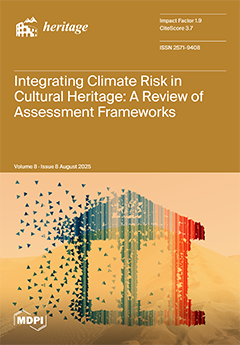The implementation of Vertical Greening Systems (VGS), like green façades, on historic building facades is approached with caution due to concerns regarding material compatibility, visual impact, and potential compromises to cultural significance. However, VGS can offer significant contributions to urban sustainability when integrated
[...] Read more.
The implementation of Vertical Greening Systems (VGS), like green façades, on historic building facades is approached with caution due to concerns regarding material compatibility, visual impact, and potential compromises to cultural significance. However, VGS can offer significant contributions to urban sustainability when integrated with knowledge and care of historic buildings by reducing the urban heat island effect, improving air quality, fostering a green economy, and creating greener environments. These tensions highlight a critical research gap: how can VGS contribute to urban sustainability while respecting the values of historic building façades? This study addresses this gap by exploring professional interest groups’ opinions on implementing VGS on historic buildings, focusing on the perceived benefits and concerns from environmental, social, economic, cultural, legal, and technical aspects. A mixed-methods approach was employed, combining the findings from the literature review with a survey targeting individuals involved in VGS implementations or heritage conservation. The survey included both open- and closed-ended questions. Of the 165 individuals contacted, 83 valid responses were analyzed. Results from the open-ended questions showed that 89% of respondents recognized the environmental benefits of VGS, while 85% raised technical issues, particularly regarding material compatibility. An important insight emerged from comparing open-ended and closed-ended responses: respondents were more likely to acknowledge the benefits of VGS when prompted. This indicates that raising awareness about the use of VGS on historic buildings is essential. The findings offer practical implications for early-stage planning, stakeholder engagement, and the design of heritage conservation policy. They illustrate a need for an informed decision-making process for the integration of VGS onto historic building facades, aligning with conservation ethics and urban sustainability.
Preface: This study aims to create a discussion on the potential synergies between vertical greening and historic buildings, with the intention of guiding future conservation strategies to enhance urban sustainability. We do not advocate for vertical greenery as a universal solution, but rather seek to explore under which conditions vertical greening may be compatible with conservation practice. For the purposes of this study, “historic buildings” refer to structures that possess cultural, architectural, or historical significance, whether they are formally protected or informally valued by their communities. We acknowledge that the term may vary in meaning across different national and cultural contexts. Moreover, our analysis focuses on cases where both the vertical greening and historic façades are presumed to be in structurally sound and well-maintained condition.
Full article





